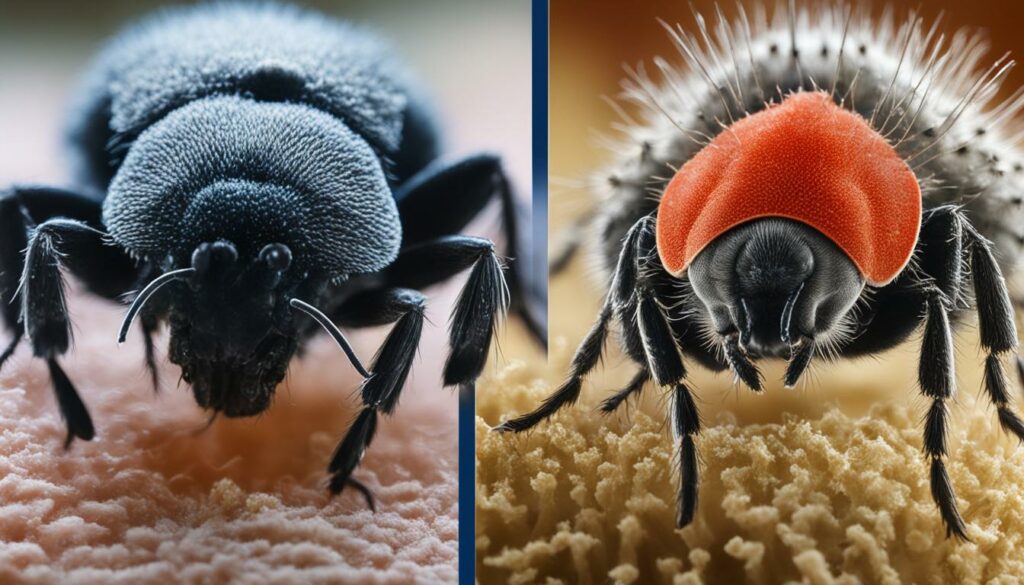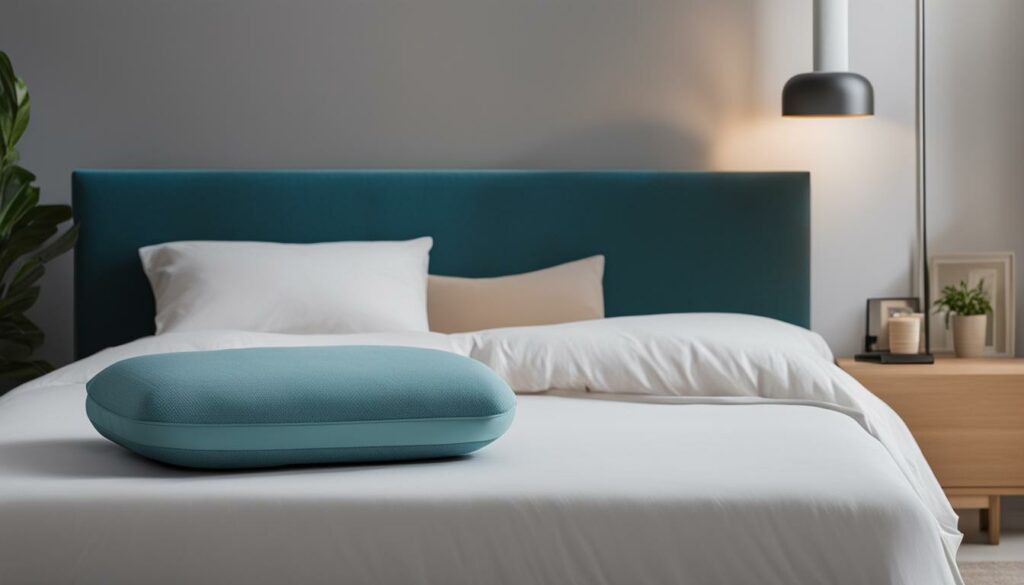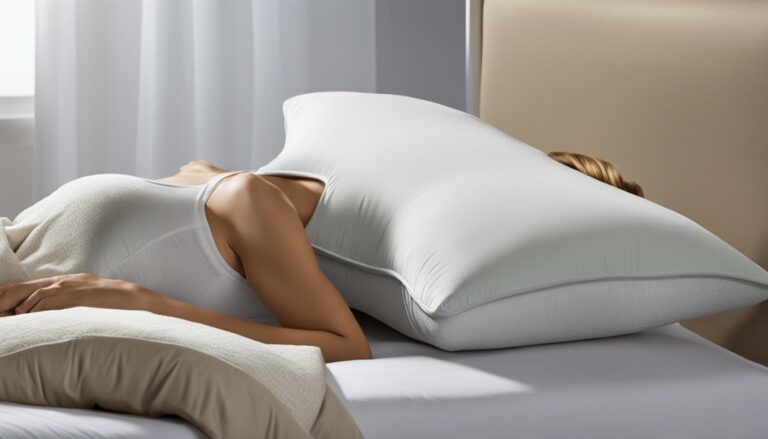Allergic Reaction to Down Pillows: Symptoms & Fixes
Eric Christie stands as a luminary in the bedding industry, with a career spanning nearly four decades since the early 1980s. His journey through the world of bedding has seen him wear many hats – a manufacturer, designer, and retailer, showcasing his versatility and expertise in Read more...
pillowsandbedsheets.com and its partners may earn a commission if you purchase a product through one of our links
If you’ve ever experienced sneezing, a runny nose, itchy eyes, or congestion after snuggling up with a cozy down pillow, you might be dealing with an allergic reaction. Feather allergy is a common condition that affects many people, causing discomfort and disrupting sleep. It’s important to understand the symptoms and explore treatment options to find relief.
Feather allergy is caused by an immune system overreaction to proteins in feathers. When exposed to these allergens, your body releases histamines, leading to the uncomfortable symptoms mentioned earlier. Understanding this condition can help you better manage and prevent allergic reactions.
In this article, we will discuss the symptoms of feather allergy, differentiate it from other allergies, explore prevention strategies, treatment options, and even alternatives to down pillows for allergy sufferers. Let’s dive in and find solutions that work for you!
Key Takeaways:
- Feather allergy can cause symptoms like sneezing, runny nose, itchy eyes, and congestion.
- Understanding the difference between feather allergy and other allergies, such as dust mite allergy, can help with effective treatment.
- Preventing down pillow allergies can be achieved by using hypoallergenic bedding options and regular pillow maintenance.
- Treatment options for down pillow allergies include allergy medications, immunotherapy, and considering alternative pillow fillings.
- Consulting a doctor for proper diagnosis and treatment is crucial for managing down pillow allergies effectively.
Understanding Feather Allergy and its Symptoms
Feather allergy is a common condition that occurs when your immune system overreacts to proteins found in feathers. These proteins can trigger a range of symptoms, including:
- Sneezing: You may experience frequent or repetitive sneezing when exposed to feather pillows.
- Runny Nose: A constant flow of nasal secretions, also known as a runny nose, is a common symptom of feather allergies.
- Itchy Eyes: Feather allergies can cause persistent itching or irritation in the eyes, leading to redness and discomfort.
- Congestion: Some individuals may experience nasal congestion or a feeling of stuffiness due to feather pillow allergies.
- Skin Irritation or Hives: Contact with feather pillows can result in skin reactions, such as redness and raised itchy bumps known as hives.
- Difficulty Breathing and Asthma: In severe cases, feather allergies can trigger difficulty in breathing, wheezing, and even asthma attacks.
If you regularly experience these symptoms after coming into contact with feather pillows, it’s likely that you have a feather allergy. These reactions can be uncomfortable and disruptive to your daily life, but there are steps you can take to manage and prevent them.
Difference Between Feather Allergy and Dust Mite Allergy
In the realm of allergies, feather allergy and dust mite allergy are two distinct conditions. While both can cause uncomfortable symptoms, it’s important to understand the differences between them to effectively manage your allergies.
Feather Allergy
In the case of feather allergy, the immune system reacts to proteins present in feathers. These proteins, when inhaled or in contact with the skin, trigger an allergic response. Symptoms of feather allergy can include:
- Sneezing
- Runny nose
- Itchy eyes
- Congestion
- Skin irritation or hives
- Difficulty breathing and asthma in severe cases
To illustrate the differences between feather allergy and dust mite allergy, refer to the table below:
| Feather Allergy | Dust Mite Allergy |
|---|---|
| Caused by proteins in feathers | Caused by proteins in dust mite feces and body fragments |
| Symptoms include sneezing, runny nose, itchy eyes, congestion, skin irritation or hives, and in severe cases, difficulty breathing and asthma | Symptoms include sneezing, runny nose, itchy eyes, coughing, wheezing, chest tightness, and shortness of breath |
| Treatment options may include avoidance, medications, and immunotherapy | Treatment options may include allergen avoidance, medications, and allergen immunotherapy |
Dust Mite Allergy
In contrast, dust mite allergy is caused by proteins found in the feces and body fragments of dust mites. Common symptoms of dust mite allergy include:
- Sneezing
- Runny nose
- Itchy eyes
- Coughing
- Wheezing
- Chest tightness
- Shortness of breath
Identifying the specific allergen that triggers your symptoms is crucial in implementing appropriate treatment strategies. While feather allergy can be managed by avoiding feather exposure and using alternative bedding options, dust mite allergy requires measures such as allergen avoidance, regular cleaning, and the use of dust mite-proof covers.
Understanding the distinctions between feather allergy and dust mite allergy enables you to take proactive steps towards alleviating your allergy symptoms and improving your overall well-being.

Preventing Down Pillow Allergies
Allergies to down pillows can cause discomfort and disrupt your sleep. To minimize the risk of experiencing allergic reactions, it is important to take preventive measures and opt for hypoallergenic bedding options. By making the right choices, you can create a sleep environment that is conducive to restful nights without the worry of allergies.
Hypoallergenic Bedding Options
Switching to hypoallergenic bedding can significantly reduce the likelihood of down pillow allergies. Consider the following options:
- Synthetic Materials: Pillows made of synthetic materials like polyester or microfiber provide an excellent alternative to down pillows. These materials are not only hypoallergenic but also offer comfort and support for a good night’s sleep.
- Down Alternative Pillows: Down alternative pillows mimic the softness and loft of down pillows without the allergens. They are filled with synthetic fibers designed to replicate the feel of down, making them a popular choice for allergy sufferers.
- 100% Cotton Pillows: Cotton is a natural and hypoallergenic option for pillows. It is breathable, soft, and resistant to allergens, making it an ideal choice for individuals with down pillow allergies.
Using pillow protectors is another effective way to prevent down pillow allergies. Pillow protectors act as a barrier, preventing allergens from penetrating the pillow’s surface. Additionally, regular washing of pillows can help remove allergens and keep your bedding clean and fresh.

The Benefits of Hypoallergenic Bedding
Hypoallergenic bedding options offer several advantages for allergy sufferers:
| Benefits | Description |
|---|---|
| Reduced Allergens | Hypoallergenic pillows are specifically designed to minimize the presence of common allergens like dust mites, molds, and dander. |
| Better Sleep Quality | By eliminating allergens, hypoallergenic bedding can provide a healthier sleep environment, leading to improved sleep quality and overall well-being. |
| Comfort and Support | Hypoallergenic pillows are engineered to offer optimal comfort and support. They are designed to maintain their shape and provide a restful sleep experience. |
| Durable and Long-Lasting | Many hypoallergenic pillow options are made with high-quality materials that are durable and long-lasting, ensuring you can enjoy allergen-free sleep for an extended period. |
Make the switch to hypoallergenic bedding options today and enjoy a restful night’s sleep without the worry of down pillow allergies.
Treating Down Pillow Allergies
If you are experiencing allergic reactions to your down pillows, there are several treatment options available to help alleviate your symptoms and improve your overall comfort. These treatments can provide relief and allow you to enjoy a restful sleep without the discomfort of allergies.
One of the first steps you can take is to use allergy medications to reduce your symptoms. Antihistamines and nasal sprays can effectively alleviate sneezing, itching, and congestion caused by down pillow allergies. These medications work by blocking the histamine release in your body, helping to relieve allergy symptoms.
In more severe cases, stronger medications such as inhaled corticosteroids or leukotriene modifiers may be prescribed by your doctor. These medications can be highly effective in reducing inflammation in your airways and respiratory system, providing significant relief from allergy symptoms.
If you’re looking for long-term relief and a reduction in your sensitivity to feather allergens, your doctor may recommend immunotherapy, also known as allergy shots. This treatment involves gradually exposing your body to small amounts of the allergen over a period of time, allowing your immune system to build up tolerance. Allergy shots can be a highly effective way to reduce the frequency and severity of allergic reactions to down pillows.
Remember, it’s essential to consult a doctor for proper diagnosis and treatment of your down pillow allergies. Your doctor can assess your symptoms, perform tests to confirm the allergy, and recommend the most suitable treatment options for your specific needs.
Treatment Options for Down Pillow Allergies
| Treatment | Description |
|---|---|
| Allergy Medications | Antihistamines and nasal sprays to reduce symptoms |
| Stronger Medications | Inhaled corticosteroids or leukotriene modifiers for severe cases |
| Immunotherapy | Allergy shots to reduce sensitivity to feather allergens |

In the table, you can see an overview of the treatment options available for down pillow allergies. Each option has its own benefits and considerations, so it’s important to discuss them with your doctor to determine the most suitable approach for your particular situation. Additionally, implementing other preventative measures, such as using hypoallergenic bedding and pillow protectors, can further enhance the effectiveness of these treatments in managing your down pillow allergies. Remember, the goal is to find the treatment plan that works best for you and provides lasting relief from your allergy symptoms.
Alternatives to Down Pillows for Allergy Sufferers
If you suffer from severe down pillow allergies, there are several alternative pillow fillings you can consider. These options provide similar comfort without triggering allergic reactions, allowing you to sleep peacefully and allergy-free. Let’s explore some popular alternatives:
Synthetic Materials:
Synthetic materials like polyester and memory foam are excellent choices for allergy sufferers. These materials are hypoallergenic and do not contain feathers or allergenic proteins. Polyester pillows are affordable, soft, and easily washable, making them a convenient option. Memory foam pillows, on the other hand, conform to your shape, offering excellent support and pressure relief.
Cotton Pillows:
Cotton is a natural and hypoallergenic filling that is resistant to dust mites and mold. Cotton pillows are breathable, allowing for better airflow and reducing the accumulation of allergens. They are soft, durable, and provide a cool sleeping surface, making them an ideal choice for those with allergies.
Here’s a comparison table to help you understand the key features of these alternative pillow fillings:
| Pillow Filling | Features | Price | Comfort Level | Hypoallergenic |
|---|---|---|---|---|
| Polyester | Soft, easily washable | Affordable | Medium | Yes |
| Memory Foam | Conforms to your shape, offers support | Higher cost | Firm | Yes |
| Cotton | Soft, breathable, resistant to dust mites and mold | Moderate | Medium | Yes |
As you can see, each alternative filling has its unique advantages. Consider your personal preferences, budget, and desired comfort level when choosing an alternative pillow filling.

A Case Study: Feather Duvet Lung and Allergic Reactions
Feather duvet lung is a rare condition known as hypersensitive pneumonitis. It occurs when individuals develop an allergic reaction to organic dust particles present in feathers. These particles can cause inflammation and irritation in the lungs, leading to various symptoms and discomfort.
Symptoms of feather duvet lung can vary from mild to severe. In some cases, individuals may experience flu-like symptoms such as fatigue, coughing, and general malaise. However, in more severe instances, acute breathlessness and difficulty in breathing may occur.
If you suspect that feather bedding may be triggering allergic reactions or causing respiratory discomfort, it is crucial to take immediate action. Removing feather bedding from your environment can be the first step towards alleviating symptoms and improving your overall well-being.
To create a safe and allergen-free sleeping space, consider switching to alternative bedding options. Synthetic materials like polyester or microfiber are hypoallergenic and can provide a similar level of comfort without triggering allergic reactions. Cotton bedding is also an excellent choice for individuals with sensitivities.
While feather duvet lung is rare, it’s essential to be aware of the potential risks associated with feather bedding for those susceptible to allergic reactions. By understanding your body’s sensitivities and making the necessary adjustments, you can create a healthier sleep environment and reduce the likelihood of experiencing allergic symptoms.
| Symptoms of Feather Duvet Lung and Allergic Reactions | Treatment and Prevention |
|---|---|
|
|
Utilizing Pillow Protectors for Allergy Relief
Allergy symptoms can be disruptive and uncomfortable, especially when they are triggered by feather allergens in pillows. Fortunately, there are effective measures you can take to reduce exposure to these allergens and alleviate your symptoms. One such solution is the use of pillow protectors specifically designed to provide allergy relief.
Pillow protectors made of hypoallergenic materials like microfiber or cotton create a barrier between your skin and the feather allergens, preventing direct contact and reducing the risk of an allergic reaction. By encasing your feather pillows with pillow protectors, you can effectively block allergen exposure and enjoy a more restful sleep.
When selecting pillow protectors, look for options that feature zipper closures. This ensures a secure fit and further prevents any allergens from escaping the protectors. The zipper closure also makes it convenient to remove the protectors for washing, allowing you to maintain a clean and allergen-free sleep environment.
In addition to reducing exposure to feather allergens, pillow protectors also offer other benefits. They can help extend the lifespan of your pillows by protecting them from stains, spills, and dust accumulation. Furthermore, by keeping your pillows clean and fresh, pillow protectors contribute to a healthier sleeping environment free from dust mites and other allergens.
Benefits of Pillow Protectors for Allergy Relief:
- Creates a barrier between skin and feather allergens
- Reduces risk of allergic reactions and symptoms
- Encases feather pillows to block allergen exposure
- Zipper closure ensures a secure fit
- Convenient for removal and washing
- Protects pillows from stains, spills, and dust accumulation
- Promotes a clean and allergen-free sleep environment
Investing in pillow protectors is a simple yet effective way to combat feather allergies and improve your sleep quality. By taking this proactive approach, you can enjoy a more restful sleep without worrying about allergic reactions interrupting your slumber.
In the next section, we will explore the importance of consulting a doctor for proper diagnosis and treatment if you suspect you have an allergy to down pillows or are experiencing allergic reactions.
Consult a Doctor for Proper Diagnosis and Treatment
If you suspect you have an allergic reaction to down pillows or are experiencing feather allergy symptoms, it is crucial to seek professional medical advice. Consulting a doctor will help you obtain a proper diagnosis and receive appropriate treatment for your condition.
During your consultation, the doctor will perform tests to confirm whether you have an allergy to down pillows. These tests may include skin prick tests or blood tests to detect specific antibodies that indicate an allergic reaction. Once the allergy is diagnosed, your doctor can recommend suitable treatment options tailored to your specific needs.
Treatment for feather allergy may involve various approaches depending on the severity of your symptoms. Your doctor may prescribe allergy medications such as antihistamines or nasal sprays to alleviate sneezing, runny nose, and itchy eyes. For more severe cases or persistent symptoms, stronger medications like inhaled corticosteroids or leukotriene modifiers may be recommended.
In some instances, your doctor may suggest immunotherapy, also known as allergy shots. This treatment involves exposing you to small amounts of the allergen over time to desensitize your immune system. Immunotherapy can be highly effective in reducing sensitivity to feather allergens and minimizing allergic reactions.
FAQ
What are the symptoms of an allergic reaction to down pillows?
Symptoms of an allergic reaction to down pillows can include sneezing, runny nose, itchy eyes, congestion, and in severe cases, difficulty breathing and asthma.
How can down pillow allergies be treated?
Down pillow allergies can be treated with allergy medications like antihistamines or nasal sprays. In severe cases, stronger medications like inhaled corticosteroids or leukotriene modifiers may be prescribed. Immunotherapy, also known as allergy shots, can also be recommended to reduce sensitivity to feather allergens.
What are the ways to prevent down pillow allergies?
To prevent down pillow allergies, it is important to avoid exposure to allergens. This can be done by using hypoallergenic bedding options such as pillows made of synthetic materials, down alternative pillows, or 100% cotton pillows. Using pillow protectors and regularly washing pillows can also help reduce exposure to allergens.
What are the symptoms of feather allergies?
Symptoms of feather allergies can include sneezing, runny nose, itchy eyes, congestion, skin irritation or hives, and in severe cases, difficulty breathing and asthma.
How do feather allergies differ from dust mite allergies?
Feather allergies are caused by proteins in feathers, while dust mite allergies are caused by proteins in dust mite feces and body fragments. The symptoms and treatment options may vary between the two conditions.
What are some hypoallergenic alternatives to down pillows?
For allergy sufferers, alternative pillow fillings such as synthetic materials like polyester or memory foam can provide similar comfort without triggering allergic reactions. Cotton pillows are also a hypoallergenic option.
What is feather duvet lung?
Feather duvet lung is a rare type of hypersensitive pneumonitis caused by organic dust from feathers. Symptoms can range from malaise and flu-like symptoms to acute breathlessness. Removing feather bedding from the environment can quickly improve symptoms.
How can pillow protectors help with feather allergies?
Pillow protectors made of hypoallergenic materials like microfiber or cotton can help reduce exposure to feather allergens. Using pillow protectors with zippers can effectively encase feather pillows and prevent allergen exposure.
What should I do if I suspect I have an allergy to down pillows?
If you suspect you have an allergy to down pillows or are experiencing allergic reactions, it is important to consult a doctor for proper diagnosis and treatment. They can perform tests to confirm the allergy and recommend appropriate treatment options.
Eric Christie stands as a luminary in the bedding industry, with a career spanning nearly four decades since the early 1980s. His journey through the world of bedding has seen him wear many hats – a manufacturer, designer, and retailer, showcasing his versatility and expertise in Read more...







